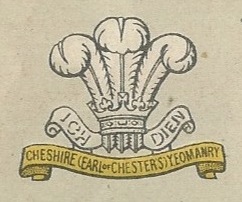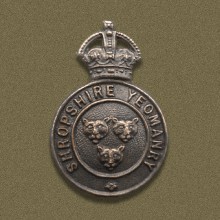The 2nd Mounted Division was a yeomanry division that served in the First World War. At the outbreak of war it was assigned to defence of the Norfolk coast. In March 1915 it formed a 2nd Line duplicate of itself, the 2/2nd Mounted Division. Leaving the 2/2nd on coastal defence, it then fought at Gallipoli from April to December 1915, under the command of Major General William Peyton, before being disbanded in January 1916.

The 74th (Yeomanry) Division was a Territorial Force infantry division formed in Palestine in early 1917 from three dismounted yeomanry brigades. It served in the Sinai and Palestine Campaign of the First World War, mostly as part of XX Corps. In May 1918 it was sent to the Western Front where it remained until the end of the war.

The Cheshire Yeomanry was a yeomanry regiment that can trace its history back to 1797 when Sir John Leicester of Tabley raised a county regiment of light cavalry in response to the growing fears of invasion from Napoleonic France. Its lineage is maintained by C Squadron, the Queen's Own Yeomanry.

The Shropshire Yeomanry was a yeomanry regiment of the British Army, first raised in 1795, which served as a cavalry and dismounted infantry regiment in the First World War and as a cavalry and an artillery regiment in the Second World War. It was then amalgamated with the Shropshire Royal Horse Artillery.
The Royal East Kent Yeomanry was a British Army regiment formed in 1794. It saw action in the Second Boer War and the First World War.

The Queen's Own West Kent Yeomanry was a British Army regiment formed in 1794. It served in the Second Boer War and the First World War. It amalgamated with the Royal East Kent Yeomanry to form the Kent Yeomanry in 1920.
The Welsh Horse Yeomanry was a yeomanry regiment of the British Army that served in the First World War. The regiment was raised shortly after the outbreak of the war. Initially it served in East Anglia on anti-invasion duties, before being dismounted in 1915 and sent to take part in the Gallipoli Campaign. After withdrawal to Egypt, it was amalgamated with the 1/1st Montgomeryshire Yeomanry as the 25th Battalion, Royal Welch Fusiliers and served as such throughout the rest of the war. It took part in the Sinai and Palestine Campaign in 1917 and 1918, before being transferred to the Western Front where it remained until the end of the war. The regiment formed 2nd and 3rd Lines in 1914, but these never left the United Kingdom before being disbanded in 1916 and early 1917, respectively. The 1st Line was disbanded in 1919.
The Royal North Devon Yeomanry was a Yeomanry regiment of the British Army. First raised in 1798, it participated in the Second Boer War and the First World War before being amalgamated with the Royal 1st Devon Yeomanry in 1920 to form the Royal Devon Yeomanry.
The London Mounted Brigade was a yeomanry brigade of the British Army, formed as part of the Territorial Force in 1908.

The 231st Brigade was an infantry brigade of the British Army that saw active service in both the First and the Second World Wars. In each case it was formed by redesignation of existing formations. In the First World War, it fought in Palestine and on the Western Front, while during the Second World War it served in the Allied invasion of Sicily, Italy and the Normandy landings of 6 June 1944.

The 2nd Dismounted Brigade was a formation of the British Army in the First World War. It was formed in Egypt in February 1916 by absorbing the Highland Mounted Brigade and the 2nd South Western Mounted Brigade. In October it absorbed the remnants of the 1st Dismounted Brigade. The brigade served as part of the Western Frontier Force and the Suez Canal Defences.
The Eastern Mounted Brigade was a formation of the Territorial Force of the British Army, organised in 1908. After serving dismounted in the Gallipoli Campaign, it was absorbed into the 3rd Dismounted Brigade in Egypt in February 1916.
The South Eastern Mounted Brigade was a formation of the Territorial Force of the British Army, organised in 1908. After service in the Gallipoli Campaign, it was absorbed into the 3rd Dismounted Brigade in Egypt in February 1916.

The British yeomanry during the First World War were part of the British Army reserve Territorial Force. Initially, in 1914, there were fifty-seven regiments and fourteen mounted brigades. Soon after the declaration of war, second and third line regiments were formed. However, the third line regiments were soon absorbed into the Cavalry Reserve Regiments, to supply replacements for the cavalry and yeomanry. Other horsed regiments in the British Army, during the war, were the regular cavalry regiments and the three regiments belonging to the special reserve: the North Irish Horse, the South Irish Horse and the King Edward's Horse. The senior yeomanry regiments could trace their origins back over 100 years; the oldest regiment, the Royal Wiltshire Yeomanry, had been formed in 1794. The most junior regiment, the Welsh Horse, had only been formed on 18 August 1914, after the start of the war.
The Royal 1st Devon Yeomanry was a Yeomanry regiment of the British Army. First raised in 1794, it participated in the Second Boer War and the First World War before being amalgamated with the Royal North Devon Yeomanry in 1920 to form the Royal Devon Yeomanry.
The 1st Dismounted Brigade was a formation of the British Army in World War I. It was formed in Egypt in February 1916 by absorbing the Lowland and Scottish Horse Mounted Brigades. The brigade was on Suez Canal defences attached to the 52nd (Lowland) Division and was broken up in October 1916.
The 1/1st Montgomeryshire Yeomanry was an active service unit formed by the Montgomeryshire Yeomanry during World War I. It was sent to garrison Egypt and then amalgamated with another dismounted cavalry unit to form an infantry battalion, the 25th Battalion of the Royal Welch Fusiliers. Serving in the 74th (Yeomanry) Division it participated in the Sinai and Palestine campaign, including the capture of Beersheba and Jerusalem. Moving with the division to the Western Front it fought in the final campaign, including the desperate Battle of Épehy, until the Armistice. The regiment won two Victoria Crosses during its service. It was disbanded after the war.
The 1/1st Pembroke Yeomanry was an active service unit formed by the Pembroke Yeomanry during World War I. It was sent to garrison Egypt and then amalgamated with another dismounted cavalry unit to form an infantry battalion, the 24th Battalion of the Welsh Regiment. Serving in the 74th (Yeomanry) Division it participated in the Sinai and Palestine campaign, including the capture of Beersheba and Jerusalem. Moving with the division to the Western Front it fought in the final campaign, including the desperate Battle of Épehy, until the Armistice. It was disbanded after the war.
The 1/1st Denbighshire Hussars was an active service unit formed by the Denbighshire Hussars during World War I. It was sent to garrison Egypt and then formed an infantry battalion, the 24th Battalion of the Royal Welch Fusiliers. Serving in the 74th (Yeomanry) Division it participated in the Sinai and Palestine campaign, including the capture of Beersheba and Jerusalem. Moving to the Western Front it fought with the 31st Divisionin the final advance in Flanders until the Armistice. It was disbanded after the war.
The Structure of the Egyptian Expeditionary Force over the course of the First World War is shown below.







